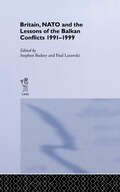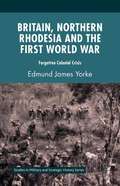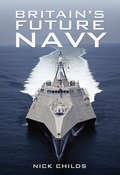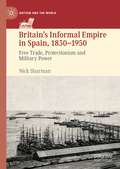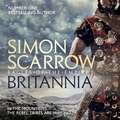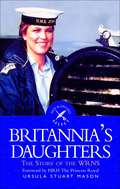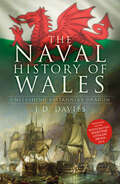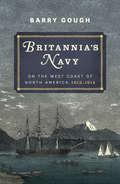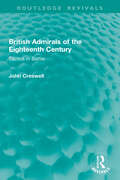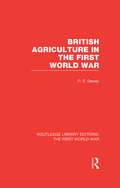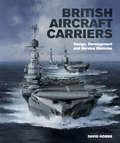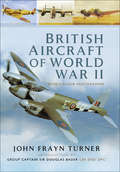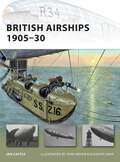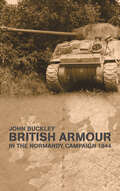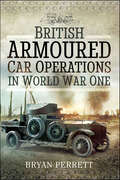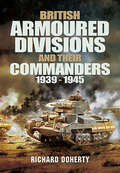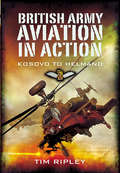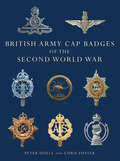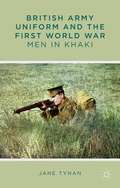- Table View
- List View
Britain, NATO and the Lessons of the Balkan Conflicts, 1991 -1999 (The\sandhurst Conference Ser. #Vol. 4)
by Paul Latawski Stephen BadseyThis publication considers the lessons to be gained for Britain, the British armed forces, and for NATO as a whole, from the Yugoslav wars of dissolution (1991-1999), with particular emphasis on the Kosovo crisis. The papers come from a diverse and high quality mixture of analysts, practitioners and policy-makers. The issues developed here represen
Britain, Northern Rhodesia and the First World War
by Edmund James YorkeBritain, Northern Rhodesia and the First World War is an insightful account of the devastating impact of the Great War, upon the already fragile British colonial African state of Northern Rhodesia. Using extensive official and private records from Britain and Zambia and the testimonies of a few surviving African veterans, Edmund Yorke investigates how rapidly rising imperial war demands caused immense distress and discontent amongst the African population. With widespread famine, spiralingdeath rates and demands for thousands more African carriers and soldiers, this book examines how African resistance rapidly mounted. Examples of rising African desertion rates and mass refusal to pay colonial taxes as well as direct defiance of military recruiters are highlighted, as are brutal reprisals by both military and some colonial officials; eventually revealing how, finally, only news from Europe of the arrival of the Armistice saved Northern Rhodesia from total collapse.
Britain, Russia and the Road to the First World War: The Fateful Embassy of Count Aleksandr Benckendorff (1903–16) (Routledge Studies in First World War History)
by Marina SorokaFor much of the later nineteenth-century Britain regarded Russia as its main international rival, particularly as regarded the security of its colonial possessions in India. Yet, by 1907 Russia's political revolution, financial collapse and military defeat by Japan, transformed the situation, resulting in an Anglo-Russian rapprochement. As this book makes clear, whilst international affairs lay at the root of this new relationship, personal factors also played an important role in reversing many years of mutual animosity and suspicion. In particular the study explores the influence of the liberal anglophile Count Aleksandr Benckendorff, the Russian ambassador in London between 1903 and 1916. By 1905, Russia's multiple weaknesses required a prolonged period of external peace by eliminating frictions with the principal rival powers, Britain and Germany, while France and Britain realised that a British rapprochement with Russia would be necessary to counter Germany's power. Benckendorff, as one of the most important figures in the Russian diplomatic service, persuaded Nicholas II and his Foreign Minister, V.N. Lamsdorff, to drop their objections to various long-standing British demands in order to pave the way for a Triple Entente. Although the overarching Russian strategy was conceived as 'balancing' the imperial rivalries of Britain and Germany, numerous factors - not least Benckendorff's energetic pro-British stance - upset the scales and resulted in a stand-off with the Central Powers. Demonstrating how Benckendorff's fear of losing Britain's friendship made him oppose all Russia's efforts at improving Russo-German relations, this book underlines the pro-Entente policy’s role in setting Russia on the road to war. For when the Sarajevo crisis struck; there was now no hope of appealing to German goodwill to help defuse the situation. Instead Russia's status within the Entente depended on a show of determination and strength, which lead inexorably to a disaster o
Britain’s Future Navy
by Nick ChildsWhat kind of Royal Navy does Britain need now? The 21st century promises to be one of huge uncertainties and challenges for the senior service. Does Britain have the right naval strategy to cope with emerging threats (does it have a naval strategy at all, and should it?) and, if so, does the Navy have the right ships and enough of them to implement it? Given the time taken to introduce changes and develop new systems, policy makers, naval chiefs, and designers are confronted with 50-year decisions. But future choices are likely to be clouded by economic uncertainties produced by the current crisis, which could have implications for decades. Nick Childs looks at the changing strategic environment (including ever greater maritime trade and the growth of other navies such as China, India, South Korea, revolutions in North Africa and the Middle East). He asks what Britain's role in the world could or should be—is she still interventionist? (Libya says 'yes'). If so, should our forces be designed purely to work with US, UN or Western European forces? What are the options for a naval strategy? The author then considers what kind of navy would be needed to support such options. What kind of ships are needed and how many? What of aircraft carriers and the nuclear option? What are the technological developments affecting current and future warship design projects? Is the new Type 45 destroyer what is needed and worth the cost? Given the depths to which the RN has shrunk in terms of numbers, public profile, and strength relative to its peers, this probably is a critical period in terms of determining the RNs future.
Britain’s Informal Empire in Spain, 1830-1950: Free Trade, Protectionism and Military Power (Britain and the World)
by Nick SharmanBased on five years of archival research, this book offers a radical reinterpretation of Britain and Spain’s relationship during the growth, apogee and decline of the British Empire. It shows that from the early nineteenth century Britain turned Spain into an ‘informal’ colony, using its economic and military dominance to achieve its strategic and economic ends. Britain’s free trade campaign, which aimed to tear down the legal barriers to its explosive trade and investment expansion, undermined Spain’s attempts to achieve industrial take-off, demonstrating that the relationship between the two countries was imperial in nature, and not simply one of unequal national power. Exploring five key moments of crisis in their relations, from the First Carlist War in the 1830s to the Second World War, the author analyses Britain’s use of military force in achieving its goals, and the consequences that this had for economic and political policy-making in Spain. Ultimately, the Anglo-Spanish relationship was an early example of the interaction between industrial power and colonies, formal and informal, that characterised the post-World War Two period. An insightful read for anyone researching the British Empire and its colonies, this book offers an innovative perspective by closely examining the volatile relationship between two European powers.
Britannia (Eagles of the Empire 14)
by Simon ScarrowIF YOU DON'T KNOW SIMON SCARROW, YOU DON'T KNOW ROME!A Sunday Times bestseller. Shortlisted for the Wilbur Smith Adventure Writing Prize.Simon Scarrow's veteran Roman soldier heroes face a cunning and relentless enemy in BRITANNIA, the unforgettable fourteenth novel in the bestselling Eagles of the Empire series. Roman Britain, AD 52. The western tribes prepare to make a stand. But can they match the discipline and courage of the legionaries?Wounded Centurion Macro remains behind in charge of the fort as Prefect Cato leads an invasion deep into the hills. Cato's mission: to cement Rome's triumph over the natives by crushing the Druid stronghold. But with winter drawing in, the terrain is barely passable through icy rain and snowstorms.When Macro's patrols report that the natives in the vicinity of the garrison are thinning out, a terrible suspicion takes shape in the battle-scarred soldier's mind. Has the acting Governor, Legate Quintatus, underestimated the enemy? If there is a sophisticated and deadly plan afoot, it's Cato and his men who will pay the price...Includes maps, chart and author Q&A.
Britannia (Eagles of the Empire 14)
by Simon ScarrowNow a Sunday Times bestseller!Simon Scarrow's veteran Roman soldier heroes face a cunning and relentless enemy in BRITANNIA. Roman Britain, AD 52. The western tribes, inspired by the Druids' hatred of the Romans, prepare to make a stand. But can they match the discipline and courage of the legionaries?Wounded during a skirmish, Centurion Macro remains behind in charge of the fort as Prefect Cato leads an invasion deep into the hills. Cato's mission: to cement Rome's triumph over the natives by crushing the Druid stronghold. But with winter drawing in, the terrain is barely passable through icy rain and snowstorms.When Macro's patrols report that the natives in the vicinity of the garrison are thinning out, a terrible suspicion takes shape in the battle-scarred soldier's mind. Has the acting Governor, Legate Quintatus, underestimated the enemy, his military judgement undermined by ambition? If there is a sophisticated and deadly plan afoot, it's Cato and his men who will pay the price.Includes maps and charts.(P)2015 Headline Digital
Britannia's Daughters: The Story of the WRNs
by Ursula Stuart MasonA comprehensive history of the Women&’s Royal Naval Service of Great Britain in the twentieth century. The Women&’s Royal Naval Service was formed in 1917 when the call was for volunteers to release a man for sea service. At the peak there was over 5,000 women serving in Britain and overseas, but efforts to maintain the service in peace time were unsuccessful. It was to be 1939, when the Second World War threatened, before the Wrens were reformed. Theirs was a different and altogether more demanding role which involved the carrying out of some highly secret and responsible duties, and many more of them served outside Britain. By 1945 there were over 75,000 officers and ratings and when the War ended, and those who wished were demobilized, a permanent Service was set up, providing a career for women alongside men of the Royal Navy. This is their story, often told in their own words, which mirrors the changing place of women in our society in a century of tremendous social progress.Features a forward by HRH The Princess Royal
Britannia's Dragon: A Naval History of Wales
by J. D. DaviesBased on extensive research, The Naval History of Wales tells a compelling story that spans nearly 2,000 years, from the Romans to the present.Many Welsh men and women have served in the Royal Navy and the navies of other countries. Welshmen played major parts in voyages of exploration, in the navy’s suppression of the slave trade, and in naval warfare from the Viking era to the Spanish Armada, in the American Civil War, both world wars and the Falklands War.Comprehensive, enlightening, and provocative, The Naval History of Wales also explodes many myths about Welsh history, naval historian J.D. Davies arguing that most Welshmen in the sailing navy were volunteers and that, relative to the size of national populations, proportionately more Welsh seamen than English fought at Trafalgar.Written in vivid detail, this volume is one that no maritime or Welsh historian can do without.
Britannia's Navy on the West Coast of North America, 1812–1914
by Barry GoughThe influence of the Royal Navy on the development of British Columbia and the Pacific Northwest was both extensive and effective. Yet all too frequently, its impact has been ignored by historians, who instead focus on the influence of explorers, fur traders, settlers, and railway builders. In this thoroughly revised and expanded edition of his classic 1972 work, naval historian Barry Gough examines the contest for the Columbia country during the War of 1812, the 1844 British response to the aggressive American agenda of President Polk's Manifest Destiny and cries of Fifty-four forty or fight, the gold-rush invasion of 30,000 outsiders, and the jurisdictional dispute in the San Juan Islands that spawned the so-called Pig War. The author also looks at the Esquimalt-based fleet in the decade before British Columbia joined Canada and the Navy's relationship with coastal indigenous peoples over the five decades that preceded the Great War.
Britannia's Shield: Lieutenant-General Sir Edward Hutton and Late-Victorian Imperial Defence ( Australian Army History Series)
by Craig StockingsBritannia's Shield: Lieutenant-General Sir Edward Hutton and the Late-Victorian Imperial Defence presents an in-depth, international study of imperial land defence prior to 1914. The book makes sense of the failures, false starts and successes that eventually led to more than 850 000 men being despatched from the Dominions to buttress Britain's Great War effort – an enormous achievement for intra-empire military cooperation. Craig Stockings presents a vivid portrayal of this complex process as it unfolded throughout the late-Victorian Empire through a biographical study of Lieutenant-General Sir Edward Hutton. As a true soldier of the Empire, the difficulties and dramas that followed Hutton's career at every step – from Cairo to Sydney, Aldershot to Ottawa, and Pretoria to Melbourne – provide key insights into imperial defence and security planning between 1880 and 1914. Richly illustrated, Britannia's Shield is an engaging and entertaining work of rigorous scholarship that will appeal to both general readers and academic researchers. The first study of imperial land defence of the British Empire prior to World War One. The first biographical study of a key late-Victorian imperial figure in Sir Edward Hutton. A truly international study using archives and sources from Britain, Australia, Canada and New Zealand.
British Admirals of the Eighteenth Century: Tactics in Battle (Routledge Revivals)
by John CreswellBritish Admirals of the Eighteenth Century (1972) examines the problems of eighteenth-century naval warfare, and differs in two important respects from orthodox opinions. It shows that the belief that the fighting instructions of the eighteenth century were Admiralty orders which cramped the initiative of admirals has been disproved by documentary evidence; and it argues that a study of the most important sea battles of the period indicates that the view that tactics at sea should always be based on principles which had been accepted as axiomatic in land warfare appears to have been misguided. The book examines the tactical problems which faced some of the greatest admirals of the time and analyses how they dealt with them.
British Aerospace Hawk: Armed Light Attack and Multi-Combat Fighter Trainer (Profiles Of Flight Ser.)
by Martin W. Bowman Dave WindleFor many years the worlds finest aerobatic team, the RAFs Red Arrows, have thrilled millions with their demonstrations of this fine aircraft's agility and maneuverability. Black Hawks can also be seen in the valleys of Wales, flying ground-hugging flight paths along the valleys. These are the aircraft used to teach flying perfection to new generations of fighter and ground-attack pilots. The aircraft has earned millions of pounds, being exported to many overseas countries.This book contains the world famous color profiles created by Dave Windle of the type in different operational modes, configurations and color schemes. Martin Bowman has written detailed descriptions and photographs to create the perfect enthusiasts reference.
British Agriculture in the First World War (Routledge Library Editions: The First World War)
by Peter DeweyThis volume comprehensively describes how British farmers coped with the problems of shortage of labour and other factors of production, as well as assessing how well agriculture performed as a supplier of food to the nation. Use of previously neglected records provides much evidence on issues such as the deployment of substitute labour and the introduction of the tractor into British farming for the first time. Challenging accepted view on the period, the author shows that shortages of labour and other factors of production had only a slight effect on farm output and the national food supply.
British Aircraft Carriers 1939-45
by Tony Bryan Angus KonstamIn August 1917, at the height of the First World War, a small biplane landed on the makeshift flight deck of HMS Furious - the first ever carrier landing in aviation history. This small act ushered in a new era. Two decades later, when Britain stood on the brink of another World War, the Royal Navy had a small fleet of aircraft carriers, with several more nearing completion. When war came the newly-formed Fleet Air Arm would demonstrate that what it lacked in modern equipment, it made up for in skill and daring. The first of these carriers were converted from existing ships. Then in 1938 HMS Ark Royal was launched - Britain's first purpose built carrier. Its design set the standard for what was to come. The "Ark" was followed by the highly successful Illustrious Class, and then by others whose design was modified in the light of wartime experience. British fleet carriers had steel flight decks, and although smaller and able to carry less aircraft that the carriers seen in the Pacific, they were better suited to conditions in European waters. It also meant they were more resilient, and could shrug off damage that would cripple their American counterparts. Over the next six years these British aircraft carriers would launch attacks against a major Italian naval base, attack the Italian battle fleet on the high seas, and cripple the Bismarck, so that the battleships of the Home Fleet could overtake her. They would also see service in every theatre of war, including the Pacific. Inevitably, their success came at a price. Courageous, Eagle and Ark Royal were torpedoed by U-Boats, Glorious was sunk by the guns of a German battlecruiser, and Hermes was lost to Japanese bombs. Most of the rest of the carrier fleet were damaged to some extent during their service lives, but they survived and kept on fighting.This New Vanguard title tells the story of these remarkable warships, and reveals the secrets of their design, how they operated, and above all, what they achieved.
British Aircraft Carriers: Design, Development & Service Histories
by David Hobbs&“This superb book . . . will undoubtedly become the definitive volume on British Aircraft carriers and naval aviation . . . magnificent.&”—Marine News This book is a meticulously detailed history of British aircraft-carrying ships from the earliest experimental vessels to the Queen Elizabeth class, currently under construction and the largest ships ever built for the Royal Navy. Individual chapters cover the design and construction of each class, with full technical details, and there are extensive summaries of every ship&’s career. Apart from the obvious large-deck carriers, the book also includes seaplane carriers, escort carriers and MAC ships, the maintenance ships built on carrier hulls, unbuilt projects, and the modern LPH. It concludes with a look at the future of naval aviation, while numerous appendices summarize related subjects like naval aircraft, recognition markings and the circumstances surrounding the loss of every British carrier. As befits such an important reference work, it is heavily illustrated with a magnificent gallery of photos and plans, including the first publication of original plans in full color, one on a magnificent gatefold. Written by the leading historian of British carrier aviation, himself a retired Fleet Air Arm pilot, it displays the authority of a lifetime&’s research combined with a practical understanding of the issues surrounding the design and operation of aircraft carriers. As such British Aircraft Carriers is certain to become the standard work on the subject. &“An outstanding highly informative reference work. It is a masterpiece which should be on every naval person&’s bookshelf. It is a pleasure to read and a pleasure to own.&”—Australian Naval Institute
British Aircraft of World War II
by John Frayn TurnerThis unique book, now republished, was the first of its kind to be published on British aircraft of the Second World War. Aviation enthusiasts and aero-modellers can see British aircraft as they really were, through magnificently reproduced colour photographs. Each of the forty-nine types of aircraft is accompanied by a brief 'biography' together with tables of the most important marks and their specifications, engine, span, length, height, weight, crew number, maximum speed, service ceiling, normal range and armament. There is also a section on British aircraft in action, which includes accounts of outstanding exploits by the pilots of different types. John Frayn Turner, the well-known aviation author, has chosen the pictures and provided the text.
British Airships 1905-30
by Tony Bryan Ian CastleAt a time when German U-Boats were ruthlessly attacking the maritime convoys engaged in bringing essential supplies to British shores, British airships played a vital role in neutralizing this danger and were crucial in enabling Britain to eventually emerge victorious. In 1907 the British Army built the military's first airship, and at the outbreak of World War I there were a total of seven airships under control of the Admiralty, hunting U-Boats from the skies. This book reveals the fascinating story of the cat and mouse duel between the airship and another pioneering form of technology - the submarine. Detailed cut-away drawings reveal the design and development of the airship, during and after the war, whilst full-color illustrations depict the airship in dramatic action shots. A tragic accident in 1930 brought the airship's military service to an end, resulting in a tiny window in which they were used and little acknowledgement over the years. Ian Knight gives deserved attention to an aeronautical wonder that for a short amount of time played a crucial service to the defense of Britain.
British Armour in the Normandy Campaign (Military History And Policy Ser.)
by John BuckleyThe popular perception of the performance of British armour in the Normandy campaign of 1944 is one of failure and frustration. Despite overwhelming superiority in numbers, Montgomery's repeated efforts to employ his armour in an offensive manner ended in a disappointing stalemate. Explanation of these and other humiliating failures has centred pre
British Armoured Car Operations in World War One
by Bryan PerrettReaders have come to expect a level of detail and critical rigour from the established military historian and author Bryan Perrett. They will not be disappointed at all here by this new publication. Focussing predominantly on the British armoured car units of World War One, it also untangles many fascinating strands forming the history of modern warfare. Full of detail, it acquaints the reader with the complete history of the armoured car, from invention onwards, setting the history of its Great War service career firmly in context. Well written in an accessible style, this publication serves as an impressive tribute to the armoured car, one of the most effective weapons utilised by the allies during the course of the Great War.
British Armoured Divisions and Their Commanders, 1939–1945
by Richard DohertyA total of eleven British armoured divisions were formed during the 1939-1945 war but, as this highly informative book reveals, just eight saw action.In 1940 only 1st Armoured Division faced the German blitzkrieg and it was in the North African desert that armoured divisions came into their own. The terrain was ideal and six such divisions of Eighth Army fought Rommel's Panzers into submission. Three were disbanded prior to the invasion of Sicily and Italy. The campaign from D-Day onwards saw the Guards Armoured, 7th Armoured (the Desert Rats), 11th and Percy Hobart's 79th Armoured Division in the thick of the action.Of particular interest are the men who commanded these elite formations and the way their characters contributed to the outcome of operations. While some, such as Dick McCreery, went onto greater heights, others did not make the grade; the stakes were high. A number, such as 'Pip' Roberts, were just perfectly suited in the role.Written by a leading military historian, this book describes many fascinating aspects of armoured warfare from its uncertain beginnings, through the development of tactics and the evolving tank design. Due to British deficiencies, reliance had to be placed on US Grants and Shermans, with the Comet coming late and the Centurion too late.The combination of gripping historical narrative and well researched fact make this an invaluable and highly readable work on the contribution of British Armoured Divisions to victory in the Second World War.
British Army Aviation in Action: Kosovo to Helmand
by Tim RipleyThe British Army is the UK's second largest operator of military aircraft, fielding more than 300 armed helicopters, fixed wing surveillance aircraft and unmanned aerial vehicles. Its aviation units have been in the forefront of UK combat air operations in Kosovo, Iraq and Afghanistan between 1999 and 2010. HRH Prince Harry was recently awarded his 'wings' to allow him to begin training as an Apache attack helicopter pilot, further raising the profile of British Army aviation. This book will look at the current units and equipment used by British Army aviation elements of the Army Air Corps (which operates helicopters and fixed wing aircraft) and Royal Artillery (which operates unmanned aerial vehicles or drones). It will provide a detailed account of British Army aviation operations, drawing on first hand accounts of army personnel and commanders, official records and the author's observations from war zones.
British Army Cap Badges of the Second World War
by Peter DoyleFor the British army, the cap badge is the most easily identifiable of insignia. It represents a distillation of the pride of the regiment, its various battle honours and symbols born proudly on the metallic emblem that was worn on all head-dress, even in the age of mechanised warfare. Identification of the cap badge on faded photographs is a first, important step in unravelling the military service of an individual; and for the soldiers of the Second World War, clad in dowdy and undistinguished battledress, its significance is enhanced still further. Cap badges have been collected avidly since they were first thought of in the nineteenth century. Cap badge collecting is as popular now as it has ever been; yet with a growing number of fakes and forgeries, there is a need for a book that illustrates clearly the main types, and allows the collector and family historian alike to understand their meaning. This book will illustrate, for the first time in high quality full colour, images of the main types of badges used by the British Army in the Second World War. With many amalgamations, war-raised units and special-forces, the insignia of the British soldier has a surprising range that differs materially from that worn by the soldier of the generation before. As with 'British Army Cap Badges of the First World War', this volume will contain contemporary illustrations of the soldiers themselves wearing the badges, a feature that has been widely applauded. Employing the skills of an established writer (and collector) and artist, it will provide a unique reference guide for all people interested in the British Army of the period.
British Army Uniform And The First World War: Men In Khaki
by Jane TynanJane Tynan offers new perspectives on the cultural history of the First World War by examining the clothing worn by British combatants on the western front. Khaki emerges as a significant part of war experience, which embodied gender, social class and ethnicity, impacted the tailoring trade and became a touchstone for pacifist resistance.
